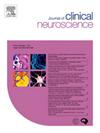The effect of temporary CSF diversion modality on shunt-dependency following aneurysmal subarachnoid hemorrhage: A nationwide assessment
IF 1.9
4区 医学
Q3 CLINICAL NEUROLOGY
引用次数: 0
Abstract
Background
Aneurysmal subarachnoid hemorrhage (aSAH) carries a high economic cost and clinical morbidity in the United States. Beyond prolonged admissions and poor post-injury functional status, there is an additional cost of chronic shunt-dependent hydrocephalus for many aSAH patients. Adjuvant lumbar drain (LD) placement has been hypothesized to promote clearance of subarachnoid blood from the cisternal space, with an ultimate effect of decreasing shunt placement rates. In this nationwide database study, we aim to evaluate outcomes associated with different forms of temporary bedside cerebrospinal fluid (CSF) diversion in the aSAH patient cohort.
Methods
Inpatient admissions were queried from the National Inpatient Sample (NIS; 2016–2020). Inclusion criteria included adult patients presenting with non-traumatic SAH that underwent treatment with either non-elective clip ligation or coil embolization of their underlying aneurysms and received either an external ventricular drain (EVD), lumbar drain (LD), or both (EVD + LD) for temporary CSF diversion during that admission. Outcome variables evaluated included inpatient mortality, bacterial meningitis, length of stay, discharge disposition, and need for shunt placement.
Results
A total of 5505 admissions met inclusion criteria, of which 18.42 % required permanent CSF diversion. The majority of patients received EVD alone (4842, 87.96 %). The remaining patients were split between LD alone (366, 6.65 %) or EVD + LD placement (297, 5.4 %). Patients receiving LD alone tended to be healthier, with lower rates of extreme APR-DRG subclass, Elixhauser Comorbidity Index (ECI), and NIS SAH Severity Score (NIS-SSS). Patients in the EVD + LD cohort had higher rates of shunt placement (OR 1.624, p = 0.0009) and higher rates of bacterial meningitis (OR 8.715, p < 0.0001), even when controlling for APR-DRG illness severity and ECI.
Conclusion
Our study found higher rates of permanent CSF diversion, longer lengths of stay, and higher rates of bacterial meningitis in patients receiving both EVD and LD placement. Due to limitations inherent to nationwide database studies, these results should be interpreted cautiously. Further studies are needed to clarify whether adjuvant temporary CSF diversion with LD placement in the aSAH cohort for intent of minimizing chronic shunt-dependence is efficacious.
临时脑脊液分流方式对动脉瘤性蛛网膜下腔出血后分流依赖的影响:一项全国性评估。
背景:动脉瘤性蛛网膜下腔出血(aSAH)在美国具有很高的经济成本和临床发病率。除了住院时间延长和损伤后功能状态差外,许多aSAH患者还需要额外的慢性分流依赖性脑积水费用。辅助腰椎引流管(LD)放置被认为可以促进池腔蛛网膜下腔血液的清除,并最终降低分流管放置率。在这项全国性的数据库研究中,我们旨在评估不同形式的临时床边脑脊液(CSF)转移在aSAH患者队列中的相关结果。方法:对全国住院患者样本(NIS;2016 - 2020)。纳入标准包括非外伤性SAH的成年患者,这些患者在入院期间接受了非选择性夹扎或螺旋栓塞治疗,并接受了外脑室引流(EVD)、腰椎引流(LD)或两者(EVD + LD)进行临时脑脊液分流。评估的结果变量包括住院死亡率、细菌性脑膜炎、住院时间、出院处置和分流器放置的需要。结果:5505例患者符合纳入标准,其中18.42%需要永久性脑脊液分流。以单纯EVD患者为主(4842例,87.96%)。其余患者分为单纯LD组(366例,6.65%)和EVD + LD组(297例,5.4%)。单独接受LD治疗的患者更健康,APR-DRG极端亚类、Elixhauser合并症指数(ECI)和NIS SAH严重程度评分(NIS- sss)的发生率更低。EVD + LD队列患者有更高的分流器放置率(OR 1.624, p = 0.0009)和更高的细菌性脑膜炎发生率(OR 8.715, p)。结论:我们的研究发现EVD和LD同时放置的患者永久性脑脊液分流率更高,住院时间更长,细菌性脑膜炎发生率更高。由于全国性数据库研究固有的局限性,这些结果应谨慎解释。需要进一步的研究来阐明在aSAH队列中,为了减少慢性分流依赖而放置LD的辅助暂时性脑脊液分流是否有效。
本文章由计算机程序翻译,如有差异,请以英文原文为准。
求助全文
约1分钟内获得全文
求助全文
来源期刊

Journal of Clinical Neuroscience
医学-临床神经学
CiteScore
4.50
自引率
0.00%
发文量
402
审稿时长
40 days
期刊介绍:
This International journal, Journal of Clinical Neuroscience, publishes articles on clinical neurosurgery and neurology and the related neurosciences such as neuro-pathology, neuro-radiology, neuro-ophthalmology and neuro-physiology.
The journal has a broad International perspective, and emphasises the advances occurring in Asia, the Pacific Rim region, Europe and North America. The Journal acts as a focus for publication of major clinical and laboratory research, as well as publishing solicited manuscripts on specific subjects from experts, case reports and other information of interest to clinicians working in the clinical neurosciences.
 求助内容:
求助内容: 应助结果提醒方式:
应助结果提醒方式:


